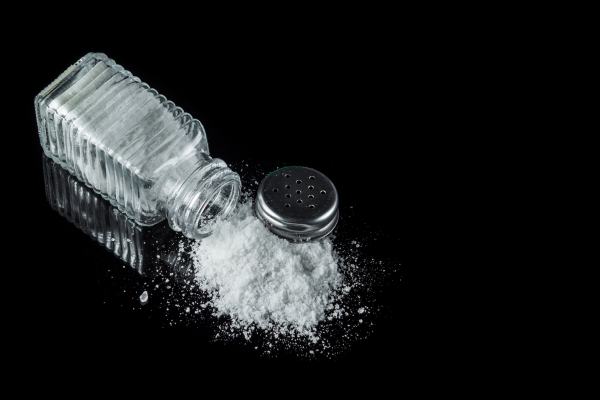GoldCare Townhall
The Pandemic Games: Deciphering the Future of Medical Tyranny
February 11th – 8 PM EST
00
DAYS
00
HOURS
00
MIN
00
SEC
September 19, 2025

The belief that salt is harmful has influenced health advice, dietary rules, and public perception. It began in 1977, when a U.S. Senate Committee urged a major reduction in sodium intake, despite weak evidence. That recommendation gained momentum, embedding itself into mainstream medicine without a strong foundation.
The most familiar argument is simple: salt elevates blood pressure, and high blood pressure leads to danger, so salt must be the culprit. This logic has driven countless patients, especially older adults, toward aggressive sodium restriction. But is it justified?
In reality, the impact of salt reduction on blood pressure is minimal, often under a 1% reduction, as shown in the most comprehensive reviews. Meanwhile, hospitalized individuals routinely receive enormous amounts of sodium chloride intravenously, up to ten times the recommended daily intake, without any significant rise in blood pressure. Clearly, the blood pressure–salt connection isn’t as clear-cut as assumed.
Moreover, overly low blood pressure, frequently the result of medication-driven targets, can decrease organ perfusion and lead to serious complications: kidney injury, cognitive decline, even macular degeneration. And those medications themselves may diminish life quality through side effects like fatigue or erectile dysfunction.
The second widespread belief is that salt intake aggravates heart failure, as it promotes fluid retention. After holidays with salty foods—think July 4th—hospitals often see a spike in admissions for heart failure flare‑ups.
That said, this scenario only applies to a narrow group: people with compromised hearts who can’t eliminate fluid effectively. It doesn’t justify salt restriction for everyone, especially when the broader evidence suggests such a ban may hurt more than help.
Pushing near-total salt avoidance can drastically reduce quality of life, and even threaten survival. Evidence shows:
Common symptoms of hyponatremia—fatigue, confusion, difficulty concentrating—frequently send people to the emergency room. Numerous individuals report that reintroducing salt into their diets restored energy levels and alleviated dizziness, findings supported by clinical studies treating orthostatic intolerance.
Low sodium has also been linked with insomnia, chronic fatigue, worsening diabetes, and stomach acid deficiencies.
In many biological systems, both deficiency and excess carry risk. Salt is no exception. Extremely low and extremely high sodium levels have both been associated with increased mortality, a classic U‑shaped relationship.
Patients with chronic kidney disease or heart failure, for instance, are often advised to avoid salt entirely. But many of those same patients have improved health when they reintroduce moderate sodium into their diets, suggesting that strict restriction may have placed them on the harmful left side of the curve. Recently, European health guidelines have begun to ease sodium restrictions for heart failure patients.
One underappreciated concept is zeta potential—the electrical repulsion or attraction between suspended particles in fluids like blood. This property helps determine whether blood components remain smooth and dispersed or begin to clump (leading to circulation problems, congestion, or even edema).
Much like sodium, optimal zeta potential follows a U‑shaped pattern: too few or too many ions disrupt circulation. Even dehydration treatments with IV saline often work not because of rehydration per se, but because they restore healthy zeta potential. Similarly, some people feel noticeably better after outpatient saline infusions, again, likely due to this restoration.
Adjusting sodium alone may not be sufficient. Processed foods, loaded with refined salt plus additives like anti‑caking agents, can impair zeta potential more than natural salt sources.
Research has shown that maintaining a balance between sodium and potassium, naturally present in many vegetables, is essential for cellular function and vascular stability. Potassium plays a key role in regulating blood pressure and can help offset some of the effects associated with sodium intake.
Salt isn't the enemy, but poor-quality, overly refined salt may be. Natural salts rich in essential minerals avoid many issues found in processed versions, which can contain bleaching agents, chemical washes (like sodium carbonate, barium compounds), or anti-caking additives that disrupt fluid dynamics.
While the original article ends before detailing specific recommended brands or practices, it invites readers to continue the discussion, promising insights on preferred salts and healthy consumption approaches.
Salt isn't inherently harmful, in fact, it’s vital to life. However, blanket restrictions and fear-driven messaging have driven many into dangerous sodium deprivation. As we've seen, both extremes—too much or too little—pose health risks. More importantly, the quality and context of sodium intake matter: refined salts and processed foods can exacerbate health issues, while balanced nutrition, including adequate potassium, supports circulation, energy, and well-being.
At GoldCare, we believe health education should be rooted in nuance, not fear. We empower our members with evidence-based guidance, personalized support, and practical tools for living well. If you're ready to move beyond rigid rules and embrace a thoughtful, science-informed approach to nutrition—safe, balanced, and life-affirming. GoldCare is here for you. Join us, and discover what informed, caring health support truly means. Click here to become a member.
Disclaimer: This content is not medical advice. For personalized guidance, please consult a GoldCare provider.
Reference:
“The Truth About Salt & Essential Fatty Acids,” The Forgotten Side of Medicine (A Midwestern Doctor Substack), published September 14, 2025. Available at The Forgotten Side of Medicine